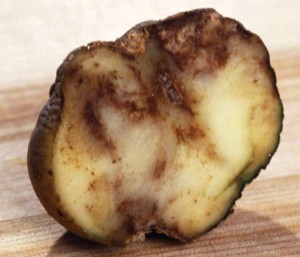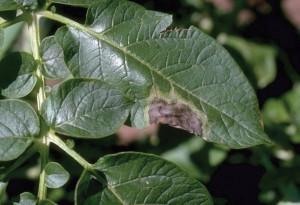Late blight outbreak affects potato producers
September 1, 2011

Debbie Carter
907-474-5406
9/1/11
Late blight has shown up in the fields of two potato producers, in Palmer and Delta Junction.
The UAF Cooperative Extension Service is working with major potato producers to help prevent the spread of the blight, a fungus-like disease that was responsible for the Irish potato famine. The disease can rapidly kill plants in the field or cause potatoes to rot in storage.
Late blight was discovered earlier this week in Palmer. Extension agriculture and horticulture agent Steve Brown said the farmer has taken proper steps to prevent further spread. Late blight can be controlled through the use of fungicides. The Delta producer is also working to prevent infecting the rest of his fields or his neighbors’.
An infected plant will appear to have brown to black lesions that develop on leaves and/or stems. Light blight spores form on the underside of leaves and will have a gray-white color. If farmers or gardeners suspect late blight, Brown suggests that they contact their local Extension agent.

Potatoes from diseased plants remain good to eat, as long as they do not show signs of the blight, but should not be stored as seed potatoes. Brown said growers should kill all affected plants within 100 feet. It takes about seven days for the highly contagious disease to develop so nearby plants are probably already infected. Options for destroying the infected plants include using a weed burner or bagging the plants and placing them in a landfill.
A hard frost and freezing temperatures will kill the disease. Delta has already experienced several light frosts. Although late blight is common in the Lower 48, it was first reported in Alaska in 1995 and there have been three subsequent outbreaks in the Matanuska-Susitna Borough region.
Jeff Smeenk, Extension horticulture specialist, said plant samples from both late blight sites will be examined to identify which type of late blight is involved. Conditions in Alaska this summer have favored the formation of blight.
“This disease likes cool and wet,” he said.
To prevent the disease, gardeners can apply fungicides with the active ingredient chlorothalonil. The fungicide is usually sold as a general-purpose garden fungicide.

• Plant only Alaska grown certified, disease-free potatoes.
• Remove and destroy any diseased plants.
• Purchase tomato transplants only germinated and grown in Alaska.
• Use an irrigation system that keeps plant leaves as dry as possible.
More information is available by calling Brown at 745-3360 or through Extension’s publications on late blight, which can be downloaded at www.uaf.edu/ces/pubs.
ADDITIONAL CONTACTS: Steve Brown, Palmer agriculture and horticulture agent, at 907-745-3360 or scbrown4@alaska.edu.
ON THE WEB: www.uaf.edu/ces
NOTE TO EDITORS: Photos are available online at www.uafnews.com.
DC/09-01-11/051-12


